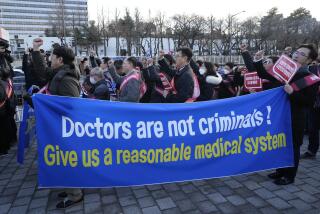More Illness and Fewer Doctors : Rural Life Worsens Medical-Care Problems
- Share via
One in every four Americans--and one in three elderly Americans--lives in a rural community, where it is not unusual to travel an hour or more for the most basic medical care.
According to the House Select Committee on Aging, rural residents have more chronic illness, higher infant-mortality rates and more serious injuries and accidents than city dwellers. Farming alone claims more than 4 1/2 times the trauma-related deaths of all other occupations.
There are also fewer doctors and nurses in rural areas to treat these afflictions: Only 14% of all physicians and 9% of all nurse practitioners work in rural areas.
Because there are so few of them, rural doctors have to work longer and harder than their urban counterparts.
“Plus, they have to practice without the comfort of having a high-tech hospital in their back yards,” said Robert Van Hook, executive director of the National Rural Health Care Assn.
Long Days
One case in point is Dr. Wayne Morton, 42, of Osceola, Mo. For Morton, the workday begins about 8:30 a.m. and ends about 10:30 p.m., 4 days a week.
Wednesday is his day “off,” when he travels the 20 miles to neighboring Humansville, Mo., to visit nursing-home patients. He and his partner, Dr. Niko Van Vanten, run family-planning, well-baby and prenatal clinics, all also on their days off. On weekends, they come in only to see their own patients and to deliver babies. Morton considers those days “off,” too.
Last year, he took 5 days for a family vacation. And in spite of the long hours, he makes much less than he could if he worked in the city.
But Morton thinks it’s worth it. He chose a rural practice because he likes the country life.
“I’d rather drive into the city once or twice a month to see a movie or a special show than have to drive to the country every weekend like some doctors do,” he said.
Getting Worse
The doctor shortage--or maldistribution, as the government likes to call it--is getting worse. A National Health Service Corps program that once provided scholarships to medical students in exchange for a commitment to practice in needy areas was cut 3 years ago by Congress. It has been replaced by loan-repayment and grant programs that provide money for students to pay off loans and to start rural practices. But fewer and fewer physicians are opting to work in rural communities.
Under the old Health Service Corps scholarship program, a physician could be assigned to a needy area. Now they must be coaxed. Loan repayment is one of the “carrots” being used by the government to coax doctors to less popular areas.
There are other carrots dangling before undecided doctors, too. Many private health organizations also offer loan-repayment programs, often in much more attractive areas.
“There are so many enticements to go elsewhere,” Van Hook said. “Continued education, a partner’s career, better schools for the kids, an easier way to live. . . . It’s really hard to live in some of these rural, depressed economies.”
Another negative factor in rural practice is Medicaid’s payment system, which authorizes lower pay for rural doctors. Morton, for example, gets reimbursed $12.80 for an office visit; he would get well over $20 in Kansas City.
“Rural doctors get the double whammy,” said Dan Hawkins of the National Assn. of Community Health Centers. “They’re paid less both because of their specialty,” which is primary care, “and because they practice in a rural area.”
Many Cannot Pay
Another grim fact is that many rural patients cannot pay their fees. According to Census Bureau figures, almost 17% of people in non-metropolitan areas are poor.
Only a small percentage of people below the poverty line qualify for Medicaid. For rural people, it is often even more difficult to qualify, in part because of a requirement that recipients must have no more than $1,000 in assets other than a home. Therefore, a farmer who owns a battered pickup truck and perhaps an old tractor does not qualify. Yet, because there is no public transportation, a truck may be essential for country living.
Hawkins said, “We’re working to have those assets that are essential for survival, like a truck or tools, exempted from the assets test.”
In the meantime, doctors like Morton and Van Vanten continue to work long hours for less pay. They do it in part because so few other doctors do.
“At least the National Health Service Corps got people to try rural medicine,” Van Hook said. “Lots of them left when their obligation was up, but sometimes they stayed. And that’s what we all hoped for.”
More to Read
Sign up for Essential California
The most important California stories and recommendations in your inbox every morning.
You may occasionally receive promotional content from the Los Angeles Times.













